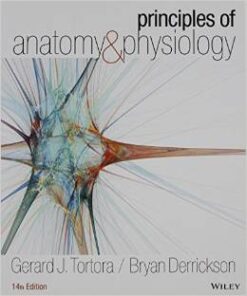Test Bank Memmler’s Structure and Function of the Human Body, 10th Edition Taylor – Cohen
$55.00
Test Bank Memmler’s Structure and Function of the Human Body, 10th Edition Taylor – Cohen
Category: Test Bank
Test Bank Memmler’s Structure and Function of the Human Body, 10e Taylor – Cohen
Chapter 6 Sample
- Bones store salts of the mineral _______________
- The shaft of a long bone is called the ______________.
- The membrane that lines the marrow cavity of a long bone is called the _____________.
- The hard bone found in the shafts of long bones is called ___________.
- The porous bone found in the ends of long bones is called _______________.
- The ends of long bones contain _________ marrow.
- The cells that produce bone tissue are called ____________.
- Most bones develop from a softer type of connective tissue that makes up most of the embryonic skeleton. This type of connective tissue is called _______________.
- A sharp projection from the surface of a bone is called a(n)
- The anatomic name for the cheekbone is the ________________.
- The skull bone that contains the internal portions of the ear is the _______________.
- The bone that contains the manubrium and xiphoid process is the _____________.
- The bone of the lower jaw is the _____________.
- The soft spots in the infant skull are called the ____________.
- The __________ curve develops when an infant holds his/her head upright.
- The lateral bone of the lower leg is the ______________.
Page 1
- The medial bone of the forearm is the ________________.
- The scientific name for the collarbone is the ___________________.
- The anatomic name for the thigh bone is the ________________.
- The bones that make up the palm of the hand are the ________________.
- The bones of the fingers and the toes are the _____________.
- The pubic symphysis is an example of a cartilaginous, slightly movable joint, or
______________.
- The bands of connective tissue that hold the bones together in a synovial joint are called
______________.
- The small, fluid-filled sacs near some synovial joints are called _____________.
- Turning the palm down or backward is called ________________.
- Drawing a large arm circle in the air is an example of the movement ______________.
- A word part meaning break is ___________________.
- Which of the following is NOT a function of the skeleton?
- blood cell production
- protection of delicate structures
- sodium storage
- providing a firm framework for the body
- A haversian canal is a
- fiber in dense bone
- meshwork in spongy bone
- depression on the surface of a bone
- channel in dense bone
Page 2
- A major component of the intercellular material of bone is the protein
- keratin
- collagen
- melanin
- calcium
- Spongy bone is found
- within the medullary cavity
- in bone epiphyses
- surrounding haversian canals
- exclusively in long bones
- Red marrow is found in
- spongy bone
- compact bone
- long bone shafts
- the medullary cavity
- The cells involved in bone resorption are
- osteoclasts
- osteoblasts
- fibroblasts
- chondrocytes
- Bone growth in children occurs in the
- center of bone shafts
- epiphyseal plates
- medullary cavities
- epiphyseal lines
- A depression on the surface of a bone is called a
- process
- sinus
- meatus
- fossa
Page 3
- An air space within a bone is called a
- sinus
- foramen
- condyle
- fossa
- A short channel through a bone is called a
- meatus
- fossa
- sinus
- depression
- The bone that forms the back and part of the base of the skull is the
- parietal bone
- temporal bone
- occipital bone
- sphenoid bone
- The bones that form the top and sides of the skull are the
- parietal bones
- temporal bones
- maxillae
- lacrimal bones
- The bone with winglike extensions located at the base of the skull is the
- ethmoid bone
- sphenoid bone
- vomer bone
- hyoid bone
- The bone located between the eyes that forms the nasal cavity roof is the
- vomer
- ethmoid
- sphenoid
- palatine
Page 4
- The section of the spinal column that forms part of the bony pelvis is the
- sacrum
- lumbar region
- thoracic region
- cervical region
- How many pairs of true ribs are found in the adult thorax?
- 7
- 9
- 5
- 13
- Skull bones are united by an immovable joint called a(n)
- suture
- amphiarthrosis
- diarthrosis
- condyloid joint
- Which bone contains the foramen magnum?
- temporal bone
- frontal bone
- occipital bone
- parietal bone
- The large soft spot at the junction of the parietal bones and the frontal bone in the infant cranium is the
- anterior fontanel
- posterior fontanel
- anterior fossa
- posterior fossa
- The secondary spinal curves are the
- cervical and lumbar curves
- cervical and thoracic curves
- thoracic and lumbar curves
- thoracic and sacral curves
Page 5
- How many phalanges are found in each hand?
- 10
- 12
- 14
- 16
- The olecranon is
- a space between vertebrae
- the part of the ulna that forms the elbow
- the lowest portion of the ischium
- the T-shaped top portion of the sternum
- A malleolus is found on the
- vertebrae
- tibia and fibula
- radius and ulna
- scapula
- What is the scientific name for the kneecap?
- manubrium
- patella
- acromion
- trochlea
- Which of the following bones is found in the shoulder girdle?
- sternum
- humerus
- scapula
- ulna
- The acetabulum is
- the joint between the first two cervical vertebrae
- the socket that holds the head of the humerus
- the tip of the sternum
- the socket that holds the head of the femur
Page 6
- The greater trochanter is a large projection on the
- humerus
- patella
- femur
- tibia
- A forensic scientist wants to identify the gender of a skeleton based on the pelvic structure. Which of the following characteristics would be found in a male pelvis?
- a wide, rounded pelvic opening
- a long, curved sacrum
- wide, flared ilia
- a wide pubic arch
- W notices that her great-grandmother is shorter than she used to be. This decrease primarily reflects changes in the height of the
- intervertebral disks
- femur
- cranium
- tibia
- Freely moveable joints are also called
- fibrous joints
- cartilaginous joints
- diarthroses
- amphiarthroses
- The smooth layer of connective tissue protecting the bone surfaces in a synovial joint is called the
- articular cartilage
- bursae
- periosteum
- endosteum
- Which of the following joint types has the smallest range of motion?
- pivot joint
- saddle joint
- ball-and-socket joint
- gliding joint
Page 7
- The turning of a bone on its own axis is called
- circumduction
- pronation
- rotation
- abduction
- When a dancer points his toes, his foot is performing the movement called
- abduction
- dorsiflexion
- plantar flexion
- pronation
- The word part cost/o refers to the
- ribs
- cranium
- arm
- pelvis
- Compare and contrast yellow marrow and red marrow. Discuss the location, constituents, and function of the two types.
- List the bones found in the bony pelvis, and name the skeletal division (axial or appendicular) for each.
- List five differences between the male and female pelvis. B. Briefly explain the benefits of the pelvic adaptations in females.
Page 8
Answer Key
- calcium
- diaphysis
- endosteum
- compact bone
- spongy (cancellous) bone
- red
- osteoblasts
- cartilage
- spine
- zygomatic bone
- temporal bone
- sternum
- mandible
- fontanels
- cervical
- fibula
- ulna
- clavicle
- femur
- metacarpal bones
- phalanges
- amphiarthrosis
- ligaments
- bursae
- pronation
- circumduction
- -clast
- C
- D
- B
- B
- A
- A
- B
- D
- A
- A
- C
- A
- B
- B
- A
- A
- A
Page 9
- C
- A
- A
- C
- B
- B
- B
- C
- D
- C
- B
- A
- C
- A
- D
- C
- C
- A
- Yellow marrow is found in the medullary cavity of long bones, whereas red marrow is found in the spongy bone at the ends of long bones and the middle of other bones. Yellow marrow is rich in fat, whereas red marrow contains many blood cell precursors. Red marrow manufactures blood cells, whereas yellow marrow stores fat but usually does not synthesize blood cells.
- The pelvis consists of the two ossa coxae (ilium, ischium, and pubis in each) of the appendicular skeleton and the sacrum and coccyx of the axial skeleton.
- The female pelvis is lighter in weight, the ilia are wider and more flared, the pubic arch is wider, the pelvic opening is wider and more rounded, the pelvic outlet is larger, and the sacrum and coccyx are shorter and straighter. B. The adaptations of the female pelvis permit women to better withstand the weight of the fetus during pregnancy and permit the fetus to pass out of the pelvis during childbirth.
Be the first to review “Test Bank Memmler’s Structure and Function of the Human Body, 10th Edition Taylor – Cohen” Cancel reply
Related products
$35.00
$35.00
$35.00
$35.00












Reviews
There are no reviews yet.